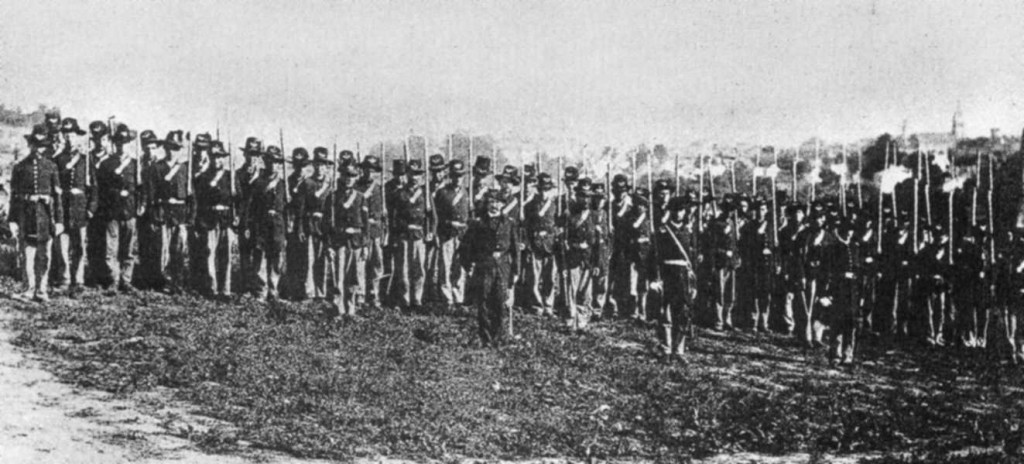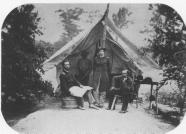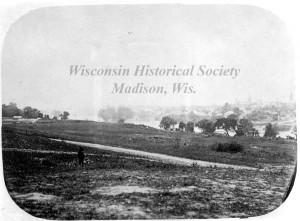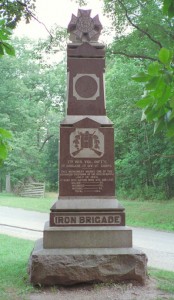Among the abundant facets the American Civil War is known for today, there are some that should stand out. The Iron Brigade and the 7th Wisconsin Volunteer Infantry proved to be a backbone for the Union throughout the war. Though the costly and excruciating battles were difficult to overcome, they earned the distinction built on discipline and determination and the men of the 7th Wisconsin Volunteer Infantry led the way to glory.

Early Days
After the shocking defeat of the Federal army at Bull Run in the summer of 1861, the volunteer companies of the 7th Wisconsin Infantry were called to assemble in Madison, Wisconsin. The 7th Wisconsin was accompanied by the 2nd and 6th Infantry Wisconsin, along with the 19th Indiana. Once assembled in Madison the 973 men which occupied the infantry were sent to march for Washington D.C. and join the King’s brigade at Camp Lyon, Virginia. During the march the major concern for the men wasn’t battle or death, but sickness. The 7th Infantry participated in all company movements through out the fall and early spring before its first skirmish in summer of 1862. General King and his men were set out to destroy the Virginia Central Railroad. This was a key part of Virginia’s vast Railroad system with its location being only 20 miles north of Virginia’s capital of Richmond. The fighting was not very severe and the men of the company suffered more from the heat of the July sun.

The spring and summer of 1862 was spent on the riverbanks of the Rappahannock. Due to the number of battles marked on Rappahannock’s banks this area was known as the bloody vortex of eastern military operation. Entrenched in the middle of it, were the men of the 7th Wisconsin Infantry. The battle of Beverly Ford is where the company first went into action as a unit. This victory was key to success because Beverly Ford is one of the few places to cross the Rappahannock River. The first real combat in the war for the 7th Infantry occurred in Gainesville, Virginia, otherwise known as Battle of Brawner’s Farm.
An attack ordered in an effort to draw General John Pope’s Union army to battle, the battle of Brawner’s Farm is known for one of the bloodiest battles in the Civil War and was fought solely by the Iron Brigade. The carnage only ceased when darkness crept upon the men ending in a stalemate. August 28, 1862 was a bloody day for the Wisconsin homestead. 46 casualties occurred throughout the duration of this day and included all of the 7th Wisconsin’s field officers. The next day, Gen. Pope urged the bulk of his army to attack “Stonewall” Jackson’s army in what is known as the Second Battle of Bull Run. During this battle the regiment was placed as a support to a battery and helped in need of retreat. On August 30, Gen. Pope ordered another attack near mid-day on Jackson’s army but the Confederates turned it back. Acting as a retreat barrier these two days, the 7th Wisconsin still suffered casualties with 5 dead and 135 wounded.
The 7th Wisconsin’s next biggest challenge came less than a month after the battle of Brawner’s Farm and Second Battle of Bull Run. The events that led up to mid-month of September 1862 helped establish the reputation of the 7th Wisconsin and the rest of the King’s Brigade. However, it was the events that occurred on September 14-18 that solidified the brigade as the Iron Brigade. These events were the battle of South Mountain and the battle of Antietam. On September 14 the battle of South Mountain took place in Frederick county, Maryland. At about 5 o’clock in the afternoon the 7th Wisconsin formed a line to defend the skirmishes that were coming through. The 7th Wisconsin then led an attack with the 6th Wisconsin some 50 paces behind and the 2nd Wisconsin securing the left flank. Running low on ammunition the 7th Wisconsin were forced to fix bayonets and reserve ammunition for close combat. The 7th Wisconsin charged no more than 20 paces and broke the lines of the enemy, which caused great confusion. The 7th Wisconsin entered the battle with 375 men and suffered 147 casualties, but the regiments fought well enough and were relieved later that night.

On September 17, the Iron Brigade embarked on the single deadliest day in American Military history with the 7th Wisconsin regiment right in the middle of it at the battle of Antietam. The day consisted of Union attacks with equally brutal counter attacks by the Confederates. Despite being outnumbered in the battle, General Lee committed nearly all of this army to the battle while General McClellan sent less than three-fourths of his men. The battle continued onto September 18 and although the battle is seen as a stalemate to a military eye, it gave President Lincoln the type of victory he needed to deliver the Emancipation Proclamation. As for the 7th Wisconsin regiment, they entered the battle with 190 men, losing 5 dead, 26 wounded, and 5 missing. Once the battle of Antietam concluded the regiment took part in the battle of Fredericksburg on December 11–15 but largely did not become actively engaged during this battle and only lost one man.
The next step for the 7th Wisconsin regiment came during the Chancellorsville Campaign with occurred during the spring of 1863. The 7th Wisconsin was with the regiment during the Fitzhugh’s crossing which after engaged the enemy at close range and drove them back. In early June of 1863 the regiment took part in reconnaissance of Culpeper Court house and served as support in the battle of Brandy Station.
The Battles Continue

One of the more iconic events that took place during the Civil War was the battle of Gettysburg. Fresh off the victory at Chancellorsville and his men in high spirits, General Lee took aim at northern Virginia and Pennsylvania. On July 1, 1863 the battle of Gettysburg commenced. At about 10 o’clock in the morning the Iron Brigade entered Gettysburg and heard shots being fired from their left. The Brigade then pushed through to a point where they could see the movement of the enemy. Their attention then turned to the left where heavy columns of Confederate troops were bearing down on them. The 7th Wisconsin was taking heavy fire and the 2nd Wisconsin was getting badly hit. The brigade was forced to fall back to Seminary Ridge where they assumed a defensive position and opened fire on the charging foe. At Seminary Ridge the enemy built a strong force along the brigade’s flanks causing yet another retreat, this time to Cemetery Hill. Once at Cemetery Hill the regiment was met with its heaviest losses of the day. However, with great bravery and prowess the men of the 7th Wisconsin were able to hold the hill. The 7th Wisconsin’s casualties at Gettysburg were striking with 26 killed, 109 wounded, and 46 missing.
Nearly three months after the battle of Gettysburg, General Lee’s men of northern Virginia lay entrenched just south of Rapidan River. Just across the river were the 7th Wisconsin and the rest of the Army of the Potomac. Lee tried to flank the Potomac and attack from the rear, but General Meade now in command of the Potomac heard of Lee’s movement and was able to fall back to Centreville. A few days later on October 19 the 7th Wisconsin lost 40 men skirmishing near Haymarket.
On May 3, 1864 nearing the latter half of the war, the battle tested regiment and the other regiments of the Iron Brigade left their winter camps in Culpeper County. The next clash that would ensue is known as the Battle of the Wilderness. On the first day of battle the tolls were immense for the 7th Wisconsin. The fighting started up again early the next morning with the 7th Wisconsin taking place in a charge against the Confederates, and was the only regiment that held their line for a short time against the Confederate front line. The issue with the battle of the Wilderness was the dense brush thickets that made fighting almost impossible in places. During this campaign that began on May 5 and extended to June 10 the 7th Wisconsin lost 92 men while 182 others were wounded.
The 7th Wisconsin went into the war having recruited 973 men. Throughout the war that number declined by 424 men. This number was eased slightly by the recruitment of 369 men during the war.
The Iron Brigade and the 7th Wisconsin Infantry Regiment earned the reputation bestowed upon them. Throughout the duration of the Civil War it would be hard pressed to find a brigade that out performed the Iron Brigade, or a volunteer regiment that showed more courage and bravery than the 7th Wisconsin did. Throughout the war the 7th Wisconsin fought in battles such as Antietam, Second Bull Run, South Mountain, and Gettysburg to name a few. At the end of the war the 7th Wisconsin Infantry ranked third on a list that recorded the number of regimental losses. The men of the 7th Wisconsin fought during some of the bloodiest moments in American Military history let alone the war, and seemed to excel when other regiments simply could not. This led to the former King’s Brigade to be renamed to the Iron Brigade, and the 7th Wisconsin was one of the main reasons they got that distinction.
Primary Sources
- Mink, Eric J. Nov. 1998. “Molding a legend: Images of the 7th Wisconsin Infantry opposite Fredericksburg, Virginia, July 1862” From Proquest.com. Military Images C/O Ronald S Coddington.
- Newspaper Clipping, 1861-1930, Vol. 7 : Wisconsin in the Civil War.” Newspaper Clippings, 1861-1930, Vol. 7 : Wisconsin in the Civil War. 1861-1930.
- “7th Wisconsin Vols. at Antietam Official Records.” From usvolunteers.org. 7th Wisconsin Vols. at Antietam Official Records.
- Quiner, B. E. “2nd Infantry, Chapter 12 from E.B. Quiner’s Military History of Wisconsin (Chicago, 1866) :: Wisconsin in the Civil War.”
- Herdegen, Lance, and Sherry Murphy. “Four Years with the Iron Brigade.” Google Books. 2002.
Secondary Sources
- “Battle of Antietam.” Council on Foreign Relations. Council on Foreign Relations. From www.civilwar.org.
- “Second Manassas.” Council on Foreign Relations. Council on Foreign Relations. From www.civilwar.org.
- “Battle of Wilderness.” Council on Foreign Relations. Council on Foreign Relations. From www.civilwar.org.
- “Gainesville.” Gainesville. From secondwi.com
- “The 7th Wisconsin Infantry at Gettysburg.” From ironbrigader.com. 22 Sept. 2014.
- “Wisconsin Historical Society.” 7th Wisconsin Infantry History. From www.wisconsinhistory.org/
- “7th Wisconsin Infantry Regiment.” 7th Wisconsin Infantry Regiment. 2009. From genealogytrails.com
For Further Reading
